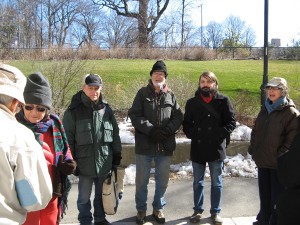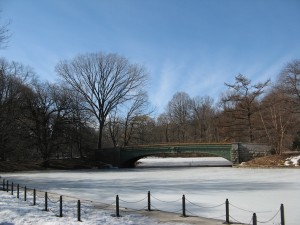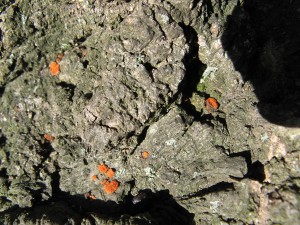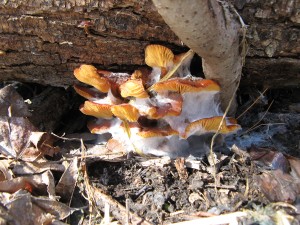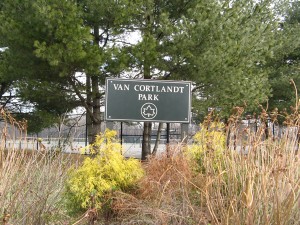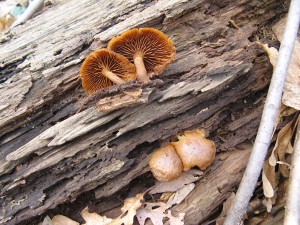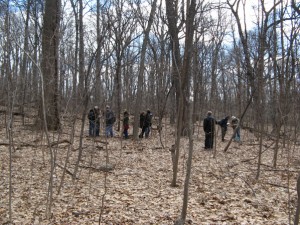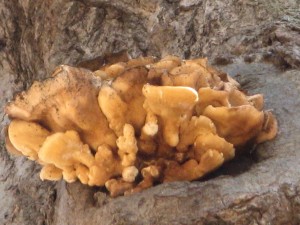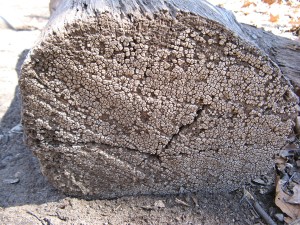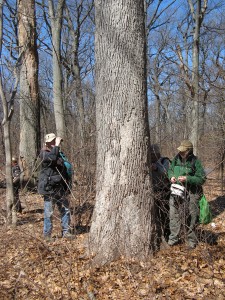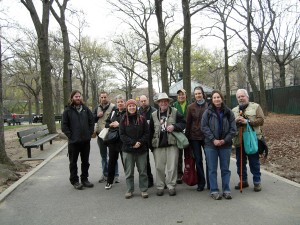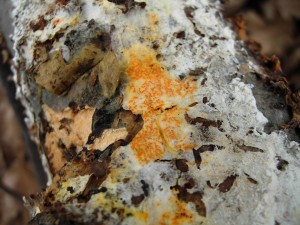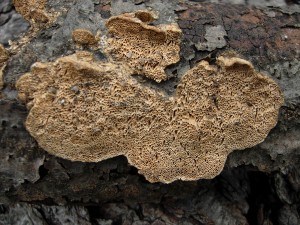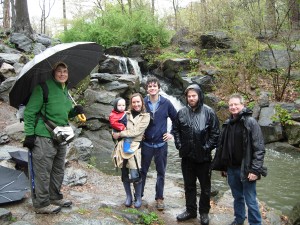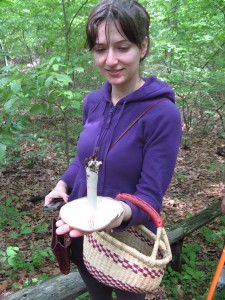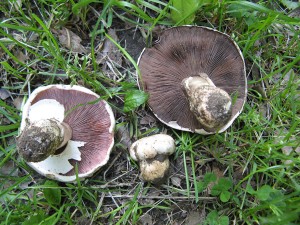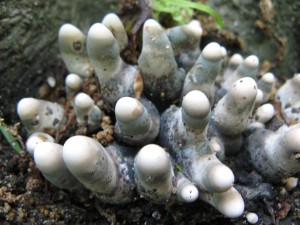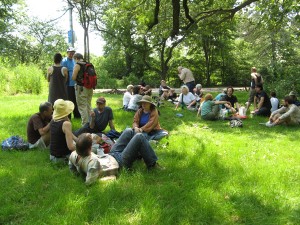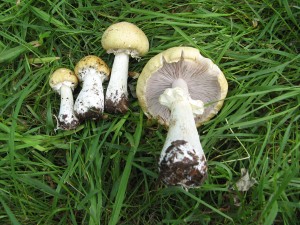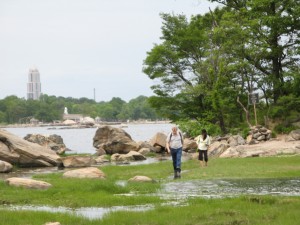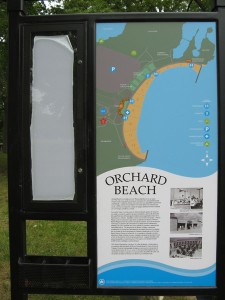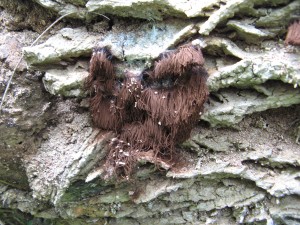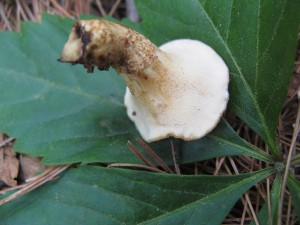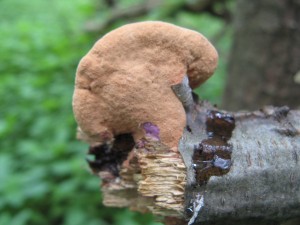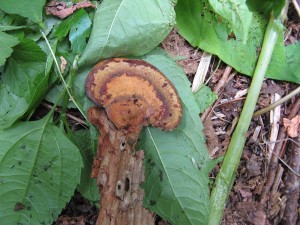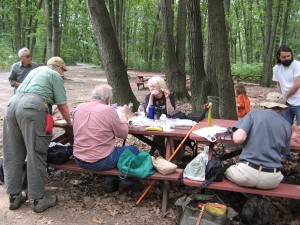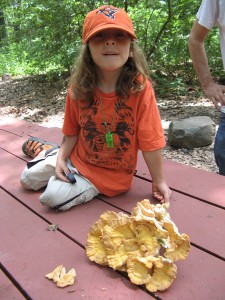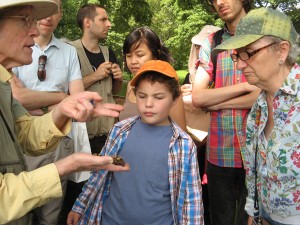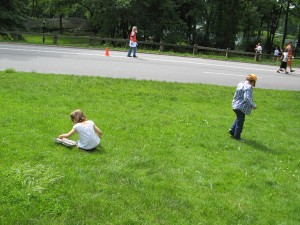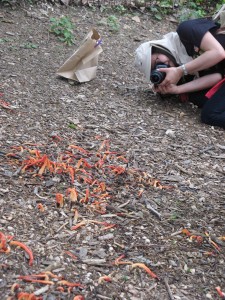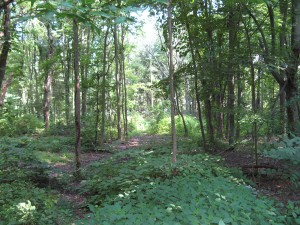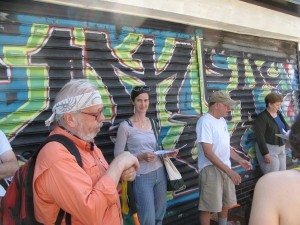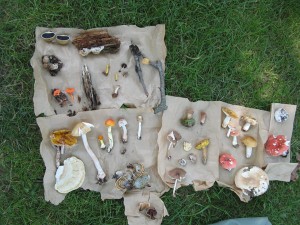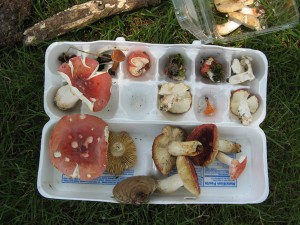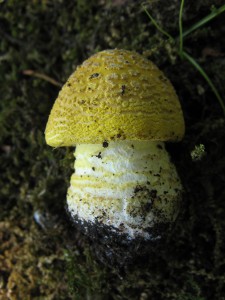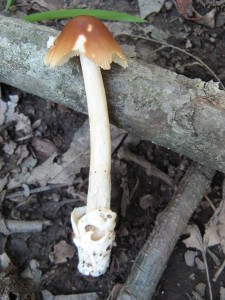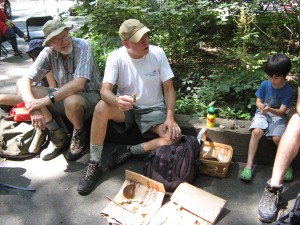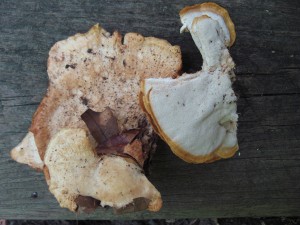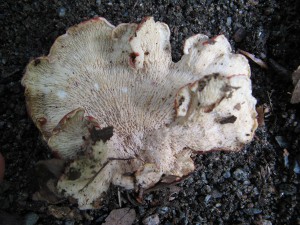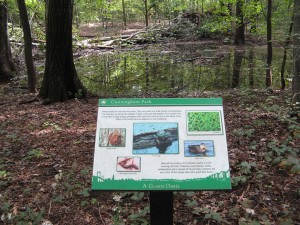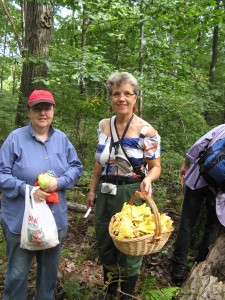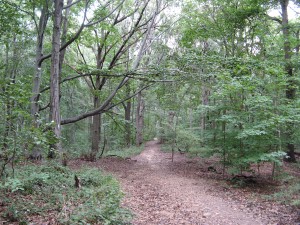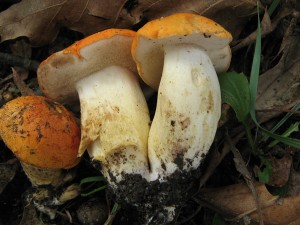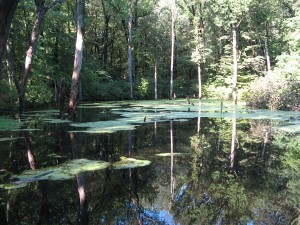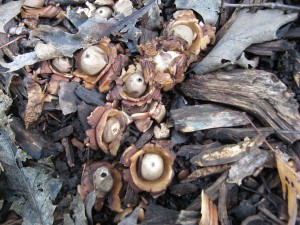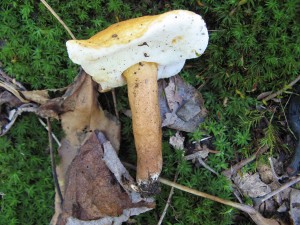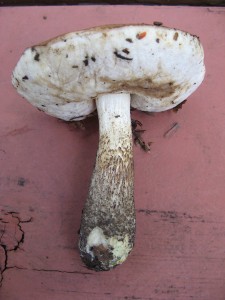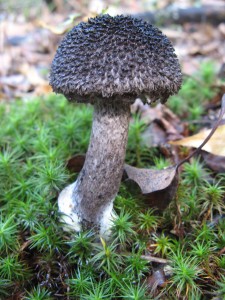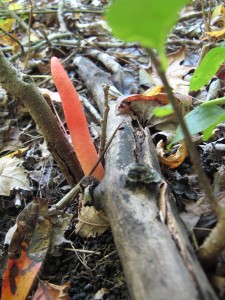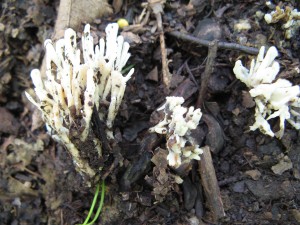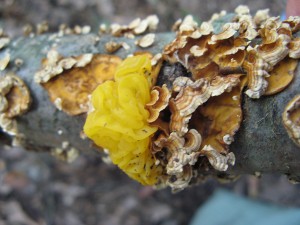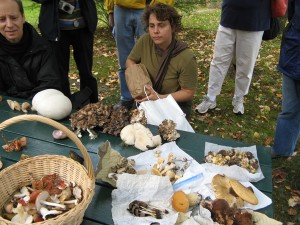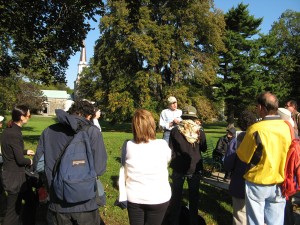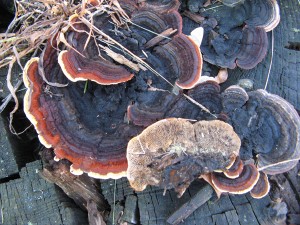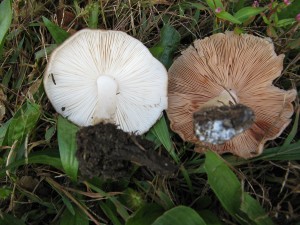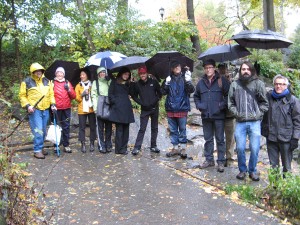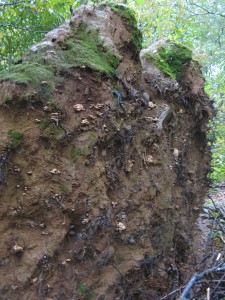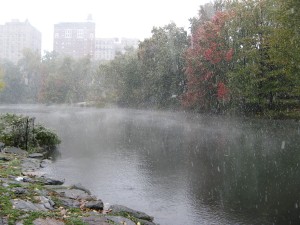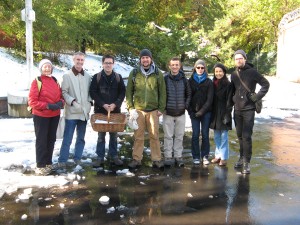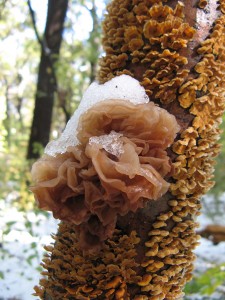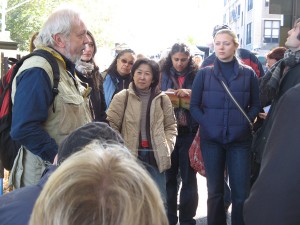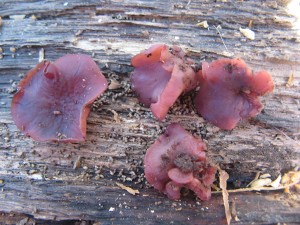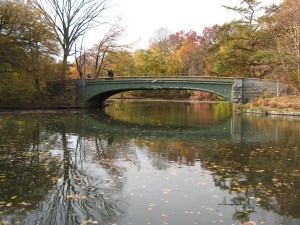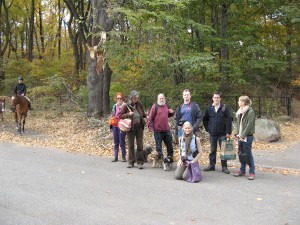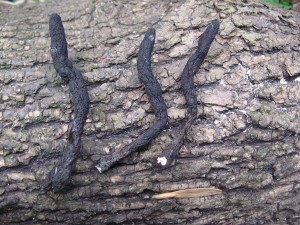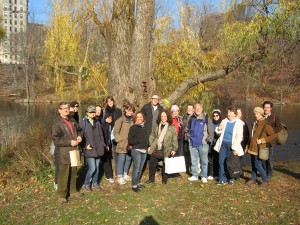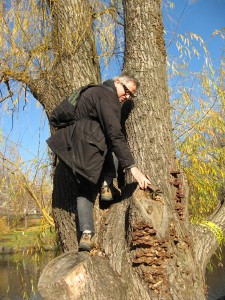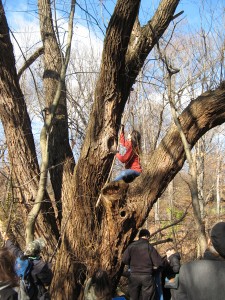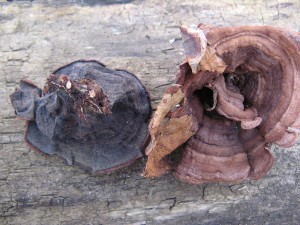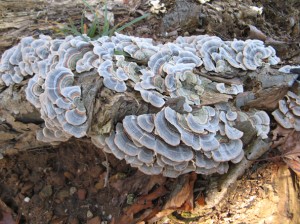THE 2011 NYMS NEW YORK CITY PARKS MUSHROOM SEASON
The New York Mycological Society has undertaken a year-round series of mushroom walks through New York City parks to see just how many mushrooms can be found in city parks and whether there is any time of year when mushrooms cannot be found. Overall, we found over 300 different mushrooms. An Excel file showing our data will be placed online during winter-spring 2012.
During 2011 we had 22 scheduled mushroom walks in New York City parks. One was in a heavy spring rainstorm, one in a freak October snowstorm, and two during a very hot and dry period in July. The last walk in 2010 was in Central Park the day after Christmas during a 17” snowstorm.
We didn’t schedule a walk in January 2011 because of the heavy snow. Our first walk of 2011 was in Prospect Park (Brooklyn) in late February, then we had two in March, one to Van Cortlandt Park (the Bronx) and the other to Forest Park (Queens). Noah Siegel was our guest speaker in April and he joined us on two walks, one to Inwood Hill Park (Manhattan), and the other in a rainstorm through Central Park. We had two walks in May, one to Forest Park, the other to Prospect Park. In June, we had 3 walks: one to Pelham Bay Park (the Bronx), one to Clove Lakes Park (Staten Island), and one to Central Park.
In July, an unusually hot and dry month this past year, considering how much it rained the rest of the year (73”), we had 3 walks, one to Wolfe’s Pond Park (Staten Island), one to Van Cortlandt Park, and one to Forest Park. No walks were scheduled in August because of the NAMA and NEMF forays. In September we had a walk to Cunningham and Alley Pond Parks (Queens). In October we had 4 walks, one to High Rock Park (Staten Island), one through Woodlawn Cemetery (the Bronx), one with Larry Millman, a guest speaker, through Central Park (in a driving rainstorm that became a blizzard), and the following day in Clove Lakes Park (Staten Island), in the snow. In November, Paul led a walk for Inwood Hill Park (Manhattan), which many members of NYMS attended, and this was followed later in the month with a walk through Prospect Park (Brooklyn). The last two walks of the year were in December in Central Park and Clove Lakes Park.
Altogether, we had 22 walks in New York City parks, covering all 5 boroughs, and surveying a dozen city parks: Manhattan [Central Park, 4; Inwood Hill, 2], the Bronx [Van Cortlandt, 2; Woodlawn, 1; Pelham Bay, 1], Brooklyn [Prospect Park, 3], Queens [Forest Park, 3; Cunningham & Alley Pond Parks, 1], and Staten Island [Clove Lakes Park, 3; Wolfe’s Pond Park, 1; High Rock, 1].
The top 3 collecting dates and places this year were: 7/10 Wolfe’s Pond Park (Staten Island) – 80 spp.; 10/2 High Rock Park (Staten Island) – 80 spp.; and 11/5 Inwood Hill Park (Manhattan)– 70 spp. We found 50 or more mushroom species on 9 of our 22 walks. Overall, just on our NYMS city mushroom walks we recognized over 300 different mushrooms! We found many others that went unidentified, and many of us found other species that occurred in NYC in 2011 but not on any of these walks. 2011 was a year to set the standard – now we have to see what we can find in 2012………
Look in your field guides and online for photos and descriptions of the mushrooms mentioned below. The mushroom names used are those most commonly recognized by members of the NYMS.
January: no NYC walks because of the deep snow.
February 20 : Prospect Park (Brooklyn)
On a cold but warming day (22 going up to 39), about 15 people attend, and we find more than 30 different species. The paths are icy but there is little snow in the wooded areas. We find a collectible quantity of Flammulina velutipes. Our most interesting find is Hypocrea citrina (or something close).
March 13 : Van Cortlandt Park (east) (the Bronx)
On an overcast and chilly, windy day, but becoming mild and going up to 50, about 15 people attend, and we find more than 50 different species. We collect in Van Cortland Park (east) in two locations: diagonally across from Woodlawn Cemetery and directly across from it. Our most interesting find is an oak tree showing, by its balding bark, the presence of Aleurodiscus oakesii (but no fruiting bodies).
March 27 : Forest Park (Queens)
About 12 people attend on a day that starts out chilly (29 degrees) but warming somewhat, and we fins more than 40 different species. Our most interesting find is Laetiporus sulphureus !!! It is high up in two trees, and each cluster of shelves looks fresh! (See photos)
April 22 : Inwood Hill (Manhattan)
A breezy and chilly day, about 45 degrees, but 15 people attend a walk scheduled with our guest speaker, Noah Siegel, and we find more than 35 different species. Our most interesting find is the pretty orange cup fungus, Arachnopeziza Aurelia.
April 23 : Central Park (Manhattan)
A hard and steady rain keeps most people away, but 6 of us join Noah Siegel in a walk about the Central Park Ravine, and we find about 30 different species, despite the weather. It is raining too hard to observe mushrooms properly, and none seem to be in a condition we could call interesting.
May 21 : Forest Park (Queens)
Nice weather brings out 15 people, and we find more than 50 different species. Our most interesting find is Polyporus craterellus, which turns up several times in the spring.
May 28 : Prospect Park (Brooklyn)
A warm, sunny day in the low 80s, and 30 people show up, and we find more than 40 different species. Our most interesting finds are Coprinus radians, with its mass of rust-colored mycelium, the startling yellow form of Stropharia rugosoannulata, and the odd looking Abortiporus biennis. (See photos)
June 5 : Pelham Bay Park (the Bronx)
A glorious day in June, sunny, with temperatures in the 60’s-70’s, but only about 10 people attend, and we find only about 24 different mushrooms. Two of the most interesting finds are a Hapalopilus nidulans, which we are able to confirm with a drop of KOH (which turns purple on contact), and Phaeolus schweinitzii, a polypore occurring only on conifers, trees not often found in numbers and surveyed in NYC parks.
June 19 : Clove Lakes Park (Staten Island)
A sunny and cloudy day, warm, in the low 80s. We find about 60 different species. Our most interesting find is Isaria (Xylocoremium) flabelliforme, an imperfect stage of Xylaria cubensis (which we have yet to see or recognize, unless it’s what we have been calling Xylaria longipes, which we find on two walks this year.)
June 26 : Central Park (Manhattan)
A perfect June day, sunny and only in the 70s, and about 40 people attend. We find over 60 different species. Our most interesting find is Resupinatus alboniger, a tiny black oyster-like mushroom that is almost identical to R. applicatus. We also find, as we do every June on this walk in this area, Amanita praecox, the tiny cream-colored, Russula-like Amanita, growing under the oaks along the 97th Street cross-walk.
July 10 : Wolfe’s Pond Park (Staten Island)
A sunny, warm day brings out 18 people and, perhaps, the heavy rain the other night, allows us to find more than 80 different species. Our most interesting finds are the vase fungus Thelephora vialis, the hairy shelf fungus Inonotus hispidus, and the pretty yellow gilled mushroom Cryptotrama asprata.
July 17 : Van Cortlandt Park (the Bronx)
It is hot and dry now, above 90 this afternoon, but 10 people attend, and we find about 24 different species. Our most interesting finds are Climacodon pulcherrimus, which we have never seen before, and Hydnellum scrobiculatum, in a year when very few species of Hydnellum are about. Very few fleshy fungi are about today.
July 31 : Forest Park (Queens)
A sunny, hot day, in the 80s, but 8-10 people attend, and we find about 40 different species. Our most interesting find is Phlebia incarnata, a species common in the mid-west but not reported before in southern New York.
August : no NYC walks because of the NAMA and NEMF forays.
Sep 25 : Cunningham & Alley Pond Parks (Queens)
A warm, sunny day, up to 80. About 15 people attend and we find more than 50 species. Cunningham Park has too many downed trees from Hurricane Irene, and most of what we find here is about the edges of the park, and we lack enough time to give Alley Pond Park a useful survey. Still, we find many new species, which encourages us to return next season. Our most interesting find is Marasmiellus nigripes.
Ocobert 2 : High Rock Park (Staten Island)
A pleasant fall day but only 10 people attend this foray to a new site on Staten Island. Even so, we find over 80 different species, clearly a place to return to. Our most interesting finds are the earthstar Geastrum triplex, the coral-like jelly Tremellodendron pallidum, and Hygrocybe marginata.
October 15 : Woodlawn Cemetery (the Bronx)
A mild, sunny, breezy day, and 25 people attend our annual foray here, and we find 50 different species. Our most interesting find is Boletus edulis! This cemetery walk has been very good year after year.
October 29 : Central Park (Manhattan)
Hard rain, and then a surprise blizzard, and temperatures dropping from 42 to 35 keep the numbers down, and reduce the ones who come, but our guest speaker, Larry Millman, attends, as do 10 other people, and we find more than 40 different species. Our most interesting find is Bulbillomyces, a basidiomycete that looks like a mass of separate tiny white eggs.
October 30 : Clove Lakes Park (Staten Island)
Heavy snow (3”-6” on the ground) and falling branches keep the numbers down, it’s sunny and warms up quickly, from 35 to 45, and 8 people attend, and we find 40 different species. Our most interesting finds are Tremella foliacea in midst of Stereum hirsutum, as well as T. “mesenterica” elsewhere also on Stereum hirsutum. Here are two different Tremella species “fruiting” on a Stereum. Tremella is a known parasite of Stereum but we rarely see it “in action.”
November 5 : Inwood Hill (Manhattan)
A sunny cool day, but 50 people show up because it’s a walk sponsored by Inwood Hill Park rather than NYMS, and we find 70 different species. Our most interesting finds are the beautiful blue crust fungus Byssocorticium atroviridis and the blueing brownish gilled “magic mushroom” Psilocybe cyanescens.
November 13 : Prospect Park (Brooklyn)
A sunny, mild day (45-60) brings out about 10 people, and we find about two dozen different species. Our most interesting find is Lenzites betulina lining the wood along the ceiling of a park bridge.
December 4 : Central Park (Manhattan)
A sunny early December day with a high in the 60s, and more than 15 people show up, and we find more than 30 different species. Our most interesting finds are the elm oyster, Hypsizygus ulmarius, high up in an elm tree, and Psathyrella conopilea, with a sparkly mushroom cap.
December 11 : Clove Lakes Park (Staten Island)
A cold but sunny day (starting at 29 but rising to 45) for our last official mushroom walk of the year, and though only 8 people come we still find 40 or so different species. The most interesting find is Camarops petersii, the dog-nose fungus. Though we found it earlier this year, seeing it in our backyard, as it were, is a sign that it might be a regular but just overlooked part of our mycoflora.
Here is a composite checklist of all species seen on NYMS walks in New York City Parks during 2011:
Consolidated checklist of NYC mushrooms for 2011…..about 165 non-gilled and 135 gilled mushrooms = 300+ species for 2011
Only scientific binomials given below – see field guides or websites or Google the names for more info…..
ASCOMYCETES…..30+
Aleuria aurantia
Amphilogia sp. (related to Nectria)
Apiosporina morbosa
Arachnopeziza aurelia
Ascocoryne cylichnium
Biscogniauxia atropunctata
Bisporella citrina
Camarops petersii
Chlorociboria aeruginascens
Diatrype stigma
Daldinia concentrica
Dasyscypha virginius
Hypocrea citrina
Hypocrea gelatinosa
Hypocrea sulphurea
Hypomyces aurantius
Hypomyces chrysospermus
Hypomyces cf hyalinus
Hypoxylon multiforme
Hypoxylon rubiginosa
Hypoxylon spp.
Kretchmaria (Ustulina) deusta
Mollisia cinerea
Peziza badia complex
Peziza sp. (on wood, but looking like a Discina)
Phaeocalicium polyporaeum
Scutellinia scutellata
Xylaria cubensis ?
Xylaria hypoxylon
Xylaria polymorpha
Xylocoremium (Isaria) flabelliforme
Tiny red disk fungus
Penicillin mold on stereum
Tulip poplar leaves…..(powdery mildew seen on many leaves)
Tree diseases in general not noted……..
[“truffles” not seen – but flying squirrels live in Inwood Hill Pk, and depend on “truffles,” ergo…]
[Morels not seen – but known to occur in Inwood Hill Park]
[False morels (Gyromitra) not seen – but collected in Westchester in March]
JELLY FUNGI……9
Auricularia auricula
Calocera cornea
Exidia glandulosa
Exidia cf nucleata (10/2 High Rock)
Exidia recisa
Tremella aurantia
Tremella foliacea
Tremella mesenterica
Tremellodendron pallidum
CHANTERELLES, CORAL & TOOTH FUNGI…..10?
Cantharellus cibarius
Cantharellus cinnabarinus
Cantharellus minor
Clavicorona pyxidata
Clavulina cristata
Climacodon pulcherrimus
Climacodon septentrionale
Hericium erinaceus
Hydnellum scrobiculatum
[Clavaria vermicularis seen in Central Park but not on NYMS scheduled walk]
PARCHMENT & CRUST FUNGI…..25+…significantly under-represented……………..
Aleurodiscus oakesii
Botryobasidium sp.
Bulbiloomyces farinosus
Byssocorticium atroviridis
Cylindrobasidium laeve
Gloeocystidiellum sp. (not verified)
Grandinia sp. (not verified)
Hyphodontia sp. (not verified)
Hydnochaete olivacea
Hymenochaete rubiginosa
Hymenochaete tabacina
Mycoacia uda ?
Peniophora albobadia
Phanerochaete chrysorhiza
Phlebia incarnata
Phlebia radiata
Phlebia tremellosa
Plicaturopsis crispa
Radulomyces copelandii ? (not verified)
Steccherinum ochraceum
Stereum complicatum
Stereum hirsutum
Stereum ostrea
Stereum striatum
Thelephora vialis
Xylobolus frustulatus
Stereoid – white with purple (2/20)
[Many other crust fungi were seen but uncollected]
POLYPORES…..45+
Abortiporus biennis
Antrodia sp. (not verified)
Bjerkandera adusta
Bondarzewia berkeleyi
Daedalea quercina
Daedaleopsis confragosa
Favolus alveolaris
Fistulina hepatica
Fomitopsis spraguei
Ganoderma applanatum
Ganoderma curtisii
Ganoderma lucidum
Gloeophyllum sepiarium
Gloeoporus dichrous
Grifola frondosa
Hapalopilus nidulans
Inonotus dryadeus
Inonotus hispidus
Irpex lacteus
Ischnoderma resinosum
Laetiporus cincinnatus
Laetiporus sulphureus
Lenzites betulina
Meripilus sumstinei
Oxyporus populinus
Perenniporia spissa
Phaeolus schweinitzii
Phellinus gilvus
Phellinus punctatus ? (not verified)
Phellinus rimosus (robiniae)
Phellinus sp. (resupinate, gray)
Physisporinus sanguinolentus
Piptoporus betlulinus
Polyporus badius
Polyporus brumalis
Polyporus craterellus
Polyporus squamosus
Polyporus varius
Pycnoporus cinnabarinus
Schizopora paradoxa
Spongipellis pachyodon
Trametes cervina
Trametes conchifer
Trametes elegans
Trametes hirsuta
Trametes versicolor
Trichaptum biforme
Tyromyces chioneus
BOLETES…..20+
Boletus campestris
Boletus carminipes
Boletus chrysenteron
Boletus edulis
Boletus iludens
Boletus innixus
Boletus pulverulentus
Boletus subglabripes
Boletus subtomentosus
Boletus subvelutipes
Gyroporus castaneus
Leccinum scabrum
Phylloporus rhodoxanthus
Strobilomyces floccopus
Suillus americanus
Tylopilus alboater
Tylopilus badiceps
Tylopilus ballouii
Tylopilus cf felleus
Tylopilus sordidus
Xanthoconium affine
PUFFBALLS and their allies……12+
Calvatia gigantea
Crucibulum laeve
Cyathus olla ?
Cyathus stercoreus
Geastrum triplex
Lycoperdon perlatum
Lycoperdon pusillum
Lycoperdon pyriforme
Mutinus elegans
Phallus ravenelii
Phallus rubicundus
Scleroderma cepa
Scleroderma citrinum
GILLED MUSHROOMS…..135-150?
Agaricus bitorquis
Agaricus campestris
Agaricus macrosporus
Agaricus placomyces
Agaricus sp. (6/26)
Agaricus sp. (6/26)
Agrocybe arvalis
Agrocybe dura
Agrocybe erebia
Agrocybe praecox
Agrocybe pediades
[Agaricus subrufescens – seen in Central Park and in the Bronx (NYBG) but not on NYMS walks]
Amanita brunnescens
Amanita citrina
Amanita crenulata
Amanita flavoconia
Amanita flavorubescens
Amanita cf fulva (but no staining volva)
Amanita praecox
Amanita rubescens
Amanita vaginata
Amanita daucipes
Amanita longipes
Amanita muscaria
Amanita onusta
Amanita cf russuloides
Amanita sect Lepidella
Amanita sp.
Armillaria mellea rhizomorphs & fruiting bodies
Armillaria tabescens
Clitocybe fasciculata
Clitocybe nuda
Clitocybe spp.
Conocybe lactea
Conocybe cf tenera
Conocybe sp.
Coprinus disseminatus
Coprinus micaceus
Coprinus quadrifidus
Coprinus radians (or C. domesticus?)
Cortinarius alboviolaceus
Cortinarius iodes
Cortinarius sect Telamonia
Crepidotus applanatus
Crepidotus crocophyllus
Crepidotus sp.
Cyptotrama asprata
Entoloma abortivum
Entoloma strictius
Flammulina velutipes
Galerina autumnalis
Galerina cf hypnorum
Gymnopilus spectabilis
Gymnopilus sapineus
Gymnopus (Collybia) acervatus
Gymnopus (Collybia) dichrous
Gymnopus (Collybia) dryophila
Gymnopus (Collybia) kauffmanii ? (not verified)
Gymnopus (Collybia) luxurians
Gymnopus (Collybia) subnuda
Hebeloma spp. [Several species seen in parks]
Hygrophorus caespitosus ? (not verified)
Hygrophorus marginatus
Hypholoma fasciculare
Hypholoma sublateritium
Hypsizygus ulmarius
Inocybe albodisca
Inocybe caesariata
Inocybe geophylla
Inocybe lacera
Inocybe spp.
Laccaria laccata
Laccaria ochropurpurea
Lactarius griseus
Lactarius hygroporoides
Lactarius luteolus
Lactarius volemus
Lactarius sp.
Lentinellus ursinus
Lepiota cristata
Lepiota sp.
Leucocoprinus cepaestipes
Lyophyllum decastes
Marasmius epiphyllus
Marasmius nigrodiscus
Marasmius rotula
Marasmiellus nigripes
Marasmius sp. (w black rhizomorphs)
Marasmiellus sp ? (not verified)
Megacollybia (Tricholomopsis) platyphylla
Micromphale sp. ? (not verified)
Mycena alcalina
Mycena galericulata
Mycena haematopus
Mycena inclinata
Mycena spp.
Omphalotus illudens
Panaeolus sp.
Panaeolina foenisecii
Panellus serotinus
Panellus stipticus
Phaeomarasmius erinaceelus ? (not verified)
Pholiota aurivella
Pholiota veris
Phyllotopsis nidulans
Pleurotus ostreatus
Pleurotus pulmonarius
Pluteus cervinus
Psathyrella candolleana
Psathyrella conopilea
Psathyrella deliniata
Psathyrella hydrophylla
Psathyrella velutina
Psathyrella spp. (many collections seen in parks)
Psilocybe cyanescens
Resupinatus alboniger
Rickenella fibula
Russula aeruginea
Russula albonigra
Russula compacta
Russula crustosa
Russula cyanoxantha
Russula foetentula
Russula mariae
Russula mutabilis
Russula ornaticeps
Russula pectinatoides
Russula subfoetens
Russula variata
Russula spp. (many species but unidentified)
Stropharia rugosoannulata (yellow form)
Stropharia rugosoannulata
Schizophyllum commune
[no Tricholomas seen on city walks in 2011]
Tubaria spp. (several collections seen Feb-Nov)
Xerula (Oudemansiella) radicata s.l.
MYXOMYCETES…..15 or so
Arcyria denudata
Ceratiomyxa fruticulosa
Comatrichia typhoides
Cribraria sp. ? (not verified)
Diachia sp. ? (not verified)
Enteridium lycoperdon
Fuligo septica
Hemitrichia serpula
Lycogala epidendron
Perichaena depressa
Physarum bivalve
Physarum diderma
Physarum globuliferum
Physarum nutans
Stemonitis spp.
Tubifera rubiginosa
Our first walk in 2012 was on New Year’s Day in Central Park. About 25 people attended and we found over 30 different mushrooms, including nice clusters of oysters and enoki. Our second walk in 2012 was in Van Cortland Park (east). About 15 people attended and we found over 50 different mushrooms, including at least 6 that are new to our lists!



